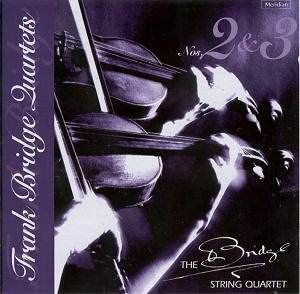This disc places side by side two works staring
uncomprehendingly at each other across the chasm created by the
Great War. This was a war with which Bridge, a lifelong pacifist,
would have no truck. He was too old to fight; instead he drank
deep of the grief of seeing friends and pupils dragged under by
the fighting. One of the first works to illustrate the psychological
change was the Piano Sonata - dedicated to his pupil Ernest Bristow
Farrar killed in the fighting and premiered by Myra Hess in 1926.
You can hear it on a Continuum disc (Peter Jacobs - either CCD
1019 or CCD 1040) though I keep wishing that Peter Wallfisch's
analogue recording, once issued on a Pearl LP, would reappear.
These two three-movement quartets are separated
by just a decade. The Second Quartet is from the second
year of the Great War - the year he also stood down as violist
of the English Quartet. At the time he was still engaged in his
romantic-impressionist phase with the roughly contemporaneous
Summer and Two Richard Jefferies Poems making the
point. The quartet won the Cobbett prize. At 2.40 of the allegro
ben moderato the great singing theme (almost Baxian in its
poignant beauty) is sung by Michael Schofield's solo viola to
the whispering accompaniment of the other members of the quartet
- superbly done. Schofield, who provides the liner notes, points
out that the English Quartet had given the premiere of the Debussy
Quartet in 1913 and that this had left its mark on Bridge. The
multiplicity of yearning lines is striking as is the allegro
vivo with its dazzling onward rush of melodic material. Profusion
and richness also characterise much of the finale which, unlike
the First Quartet, ends rather conventionally in a stertorous
gulp.
The Third Quartet finds a clarity - in
fact a spareness and even a desolation - alien to the romantic
apparatus of the first two quartets. Michael Schofield, in his
notes, aptly points out the change to a style that presages the
Berg Violin Concerto and links naturally to two works from 1927:
There is a Willow Grows Aslant a Brook and Enter Spring.
Compared with the first two quartets the Third inhabits a post-holocaust
wasteland. Bridge does the eldritch bleak thing very well indeed.
One can perhaps compare the effect this work had on the listening
public with the impact Sibelius had with his Fourth Symphony on
audiences used to the Tchaikovskian effusions of the first two
symphonies. Surprisingly, the Third Quartet is an even tougher
work than its successor.
Bridge's great gifts in quartet writing, never
in doubt, were honed by his years as violist, first with the Grimson,
then with the English. He also deputised in the Joachim Quartet.
There is competition for the Bridge Quartets.
The New Zealand based label Continuum recorded them complete on
two CDs with the Brindisi Quartet (the first intégrale).
Like the Meridians these are only available separately. The harnessing
arrangements are different so there is no exact comparison disc
to disc. Continuum CCD 1035 couples numbers 1 and 3; CCD1036,
2 and 4. The Brindisi are recorded in a cooler acoustic and marginally
less closely than the Bridge. The Bridge are more cautious in
tempi than the Brindisi especially in the last two quartets. The
Brindisi bring out the parallels with Bridge's Roger de Coverley
arrangement in the second movement of the Second Quartet.
Warm and close recordings in utterly committed
performances. Bridge's chilliest quartet matched with one of denser
romantic fibre.
Rob Barnett
see also quartets 1,4

